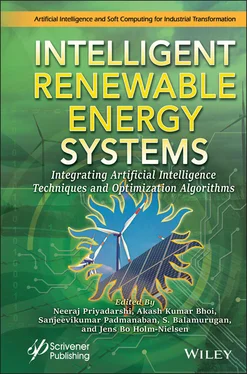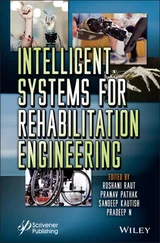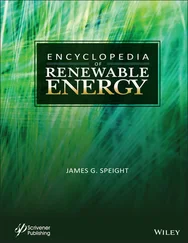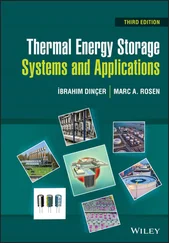(1.7) 
As mentioned earlier the mixed discrete SPBO is capable to handle both the continuous and discrete variables. In the mixed discrete SPBO, the continuous variables are updated as the conventional SPBO. The updating process of the continuous variables is the same as discussed in the previous section using four categories of students (namely best student, good student, average student, and students who want to improve randomly) with the help of (Equations 1.1– 1.4). For the discrete variables, the discretization may be done with the help of the nearest vertex approach (NVA). The NVA method is normally based on finding out the Euclidean norm in the design space. The discrete variables may be expressed in terms of a hypercube, which are represented by the sets of ordered pair and can be represented as in (Equation 1.8)
(1.8) 
where,  are the lower and upper limits of the discrete variables, in the hypercube. In the hypercube, the lower and upper limit can be defined by floor and ceiling functions as presented in (Equation 1.9) and (Equation 1.10), respectively.
are the lower and upper limits of the discrete variables, in the hypercube. In the hypercube, the lower and upper limit can be defined by floor and ceiling functions as presented in (Equation 1.9) and (Equation 1.10), respectively.
(1.9) 
(1.10) 
where, ℤ +is the set of integers. In the hypercube H , the closest vertex of the discrete variables can be determined using the NPV method as expressed in (Equation 1.11).
(1.11) 
where,  is the discrete version of the continuous variable Xij . To restrict the variables within the boundary of minimum and maximum limit the same procedure may be used as used in the conventional SPBO algorithm.
is the discrete version of the continuous variable Xij . To restrict the variables within the boundary of minimum and maximum limit the same procedure may be used as used in the conventional SPBO algorithm.
1.3 Problem Formulation
1.3.1 Objective Functions
The selection of the locations and the proper sizes of the RDGs (biomass and solar PV) and shunt capacitors in the distribution networks depend on the selection of the proper objective functions. Improper placement of the RDGs and shunt capacitors leads to the maloperation of the distribution networks which includes the increment in active power loss, poor voltage profile, and huge installation cost. In this book chapter, the active power loss, voltage deviation, and the effective annual installation cost of RDGs and shunt capacitors are considered as the main objective functions. The multi-objective function is converted to the single objective function by using the weighted sum approach, where the weights for the objective functions are selected based on their preferences. The objective function with the weights is stated in (Equation 1.12).
(1.12) 
(a) Power Loss Index (PLI)
PLI is the ratio of the active power losses after and before the placement of RDGs and the shunt capacitors. PLI is defined as in (Equation 1.13).
(1.13) 
The  are the active power loss after and before the placement of RDGs and shunt capacitors, respectively, at the time instant t .
are the active power loss after and before the placement of RDGs and shunt capacitors, respectively, at the time instant t .
The active power loss at any time instant t can be defined as in (Equation 1.14)
(1.14) 
where NBr is the total number of branches, Zi is the branch impedance and | Iij | is the magnitude of the branch current, connected between bus- i and bus- j , defined as in (Equation 1.15).
(1.15) 
After the RDGs and shunt capacitors connected to the distribution networks, the branch current magnitude | Iij | is modified by (Equation 1.16).
(1.16) 
Here,  are the voltage magnitude and the load angle after inserting the DGs and shunt capacitors.
are the voltage magnitude and the load angle after inserting the DGs and shunt capacitors.
(b) Voltage Deviation Index (VDI)
Improvement in the voltage profile in the distribution network is measured by voltage deviation from the nominal voltage of 1.0 pu. The voltage deviation index is measured as the ratio of the voltage deviations (VDs) after and before the placement of the RDGs and shunt capacitors which are defined for the time instant t as
(1.17) 
where VDDG is defined as
(1.18) 
(1.19) 
Here,  are the voltage of i th bus after and before placement of DG to the distribution network. The value of voltage deviation near zero indicates an improved voltage profile.
are the voltage of i th bus after and before placement of DG to the distribution network. The value of voltage deviation near zero indicates an improved voltage profile.
(c) Installation Cost Index (ICI)
Total installation cost includes the cost of the RDGs and the shunt capacitors. Lifetime (LT) of the RDGs and the shunt capacitors are used to obtain the annual installation cost. The ICI is defined as
(1.20) 
Here, CostDG ( t ) is the effective annual installation cost of the DGs and shunt capacitors at time instant t , and can be defined as
Читать дальше



 are the lower and upper limits of the discrete variables, in the hypercube. In the hypercube, the lower and upper limit can be defined by floor and ceiling functions as presented in (Equation 1.9) and (Equation 1.10), respectively.
are the lower and upper limits of the discrete variables, in the hypercube. In the hypercube, the lower and upper limit can be defined by floor and ceiling functions as presented in (Equation 1.9) and (Equation 1.10), respectively.


 is the discrete version of the continuous variable Xij . To restrict the variables within the boundary of minimum and maximum limit the same procedure may be used as used in the conventional SPBO algorithm.
is the discrete version of the continuous variable Xij . To restrict the variables within the boundary of minimum and maximum limit the same procedure may be used as used in the conventional SPBO algorithm.

 are the active power loss after and before the placement of RDGs and shunt capacitors, respectively, at the time instant t .
are the active power loss after and before the placement of RDGs and shunt capacitors, respectively, at the time instant t .


 are the voltage magnitude and the load angle after inserting the DGs and shunt capacitors.
are the voltage magnitude and the load angle after inserting the DGs and shunt capacitors.


 are the voltage of i th bus after and before placement of DG to the distribution network. The value of voltage deviation near zero indicates an improved voltage profile.
are the voltage of i th bus after and before placement of DG to the distribution network. The value of voltage deviation near zero indicates an improved voltage profile.











